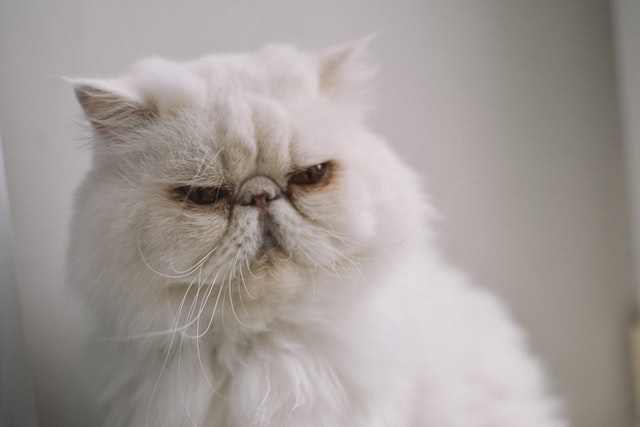Description
Although the modern Persian cat resembles the Persian cats that traveled with sailors to Europe and America in the 19th century, it is a relatively new breed that has evolved in its present form only since the mid-20th century.
The Persian’s long hair requires frequent grooming. Some say daily, but many Persian lovers will tell you they can get away with less because their Persian has been outcrossed to another breed which results in them being more or less “hypoallergenic”, but there have been no studies on this so far so nothing is known for sure.
In addition Persian cats are not really hypoallergenic as some people believe; all cats produce allergens. Persian cats do tend to produce less allergens than other breeds but they will still cause an allergic reaction in some people.
The Persian is a long-haired breed of cat characterized by its round face and shortened muzzle. It has been selectively bred for many generations for the characteristic traits of the Persian: large eyes, short nose, and ears with the top half folded forward. Persian cats come in a wide variety of coat colors and patterns. The Persian’s docile disposition and affectionate nature make it a popular family pet. Persian are also known for their “sweet breath,” due to a combination of the shape of its head and a genetic quirk that causes saliva to build up on their teeth more often than with other breeds. Persian cats can be very playful, but are also quite the couch potatoes, enjoying lounging around with their humans. Persian cats are extremely adaptable and thrive in virtually any environment they find themselves in, including small apartments. Persian love children; they tend to be more patient than most cats with smaller kids who may tug at ears or tails. Persian often become very attached to their owners, following them around like a dog would do.
They are sociable towards strangers as well as dogs and other animals if they’re brought up together.
One of the ongoing genetic issues that Persian breeders face is polycystic kidney disease (PKD), which causes multiple cysts to grow in the kidneys, ultimately causing kidney failure. PKD is an autosomal dominant genetic trait, meaning if a Persian kitten receives the gene from any one parent it will develop the disease. Persian breeders who plan to use their cats for breeding must have their cats tested by veterinarians to determine whether or not they are carriers of the PKD gene. If both parents are clear of the PKD mutation, there is no guarantee that kittens developed from that Persian will be free of PKD.
Some Persian breeders use outcrossing to increase genetic diversity in their breeding lines while others select only Persians with desirable traits as breeding stock for their catteries. Persians with folded ears are often selected since fewer were available, but good Persian breeders only breed the healthiest with the best inner ear structure.
The Persian is generally described as a quiet cat. They are also known for being very social with humans, especially their owners, making excellent pets for families that have children, seniors living by themselves, or people who live in apartments. Persian cats are more vocal than most other breeds of cats and will tell their owners when something is wrong by meowing loudly. Persians are highly adaptable to different environments; they can be easily kept indoors and usually get along well with other household pets like dogs or birds.[8][13] Persian temperament varies greatly among individual cats (just like humans), but they typically love to cuddle and prefer to stay close to their humans.
Although Persian cats are more docile than other breeds, they do require regular grooming. Persian coats tend to mat easily when not groomed regularly, with the fur tangling around the legs and stomach (known as “kitten bunt”) being a particular issue. Persian owners can choose between different styles of Persian coat; some choose the longhaired Persian, often called a Cobby Persian for its stockier build, while others may choose the semi-longhair or shorthaired Persian. Longhaired Persians have soft, smooth coats that are easy to groom, while shorthaired Persians have more of a bristly texture, similar to many other shorthaired breeds, and require more grooming. Persian cats shed throughout the year, but there are times when Persian cat shedding increases significantly. Persian cats reach maturity between three and five years of age, at which time they need not be neutered or spayed unless medical problems necessitate it.
The Persian’s nose should be black with clearly delineated nostrils; blue-coated Persians often have a copper-colored nose, while chocolate coats may have brown noses. Brown is also acceptable on noses of lilac or fawn colored Persian kittens. A pink nose is considered a serious fault in the show ring for all colors other than chocolate (which automatically makes “red” Persian an incorrect coat color). Persian cats may have almost any eye color, including turquoise and odd-eyes (both eyes of different colors).
The Persian cat breed has a wide variety of eye colors; the most common are green and gold. Less common varieties include amber, turquoise and odd colored (heterochromic) eyes. The International Cat Association recognizes the following Persian coat colors: Brown, Black, Blue, Cream, Red/Cameo/Lynx Point (not to be confused with Chocolate), Lilac or Fawn (no dilution factors allowed), Chocolate(Chocolate Dilute is NOT recognized by TICA ), and White. All Persian cats with the exception of white carry one copy of the Persian color gene. Persian cats with white coats are known as “odd-eyed” because they have one yellow/gold eye and one blue eye. Persian cats do not carry the albino gene. The Persian cat breed comes in many different coat patterns, including the traditional or doll-face Persian, which has an egg-shaped head, no muzzle (called a “peke face”) and round eyes; the slightly less extreme Peke-faced Persian, with a muzzle and more rounded eyes; the Persian Princess or Ultra Doll face Persian, characterized by even rounder features than its counterpart; and the Persian cat by another name,[20] Himalayan, again distinguished from the Persian by a longer muzzle and larger ears.







Reviews
There are no reviews yet.